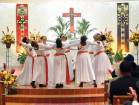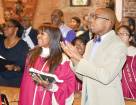




St. Charles Borromeo Church has been called “The Cathedral of Harlem,” and that appellation would seem apt. For one thing the imposing stone neo-Gothic church that sits mid-block on 141st Street played host to Pope John Paul II when he visited New York City in 1979, and few parishes can make that claim.
But the historic parish, which celebrated its 125th anniversary this year, has also played a pivotal role in the creation of a Catholic presence in Harlem.
It was, in fact, all done very deliberately, noted Father Gregory Chisholm, S.J., the current pastor. When the present structure was completed in 1904, the surrounding community was largely Irish and Catholic. But it wasn’t too long after the parish opened that the neighborhood began to change. African-Americans were moving in, and the Irish were moving out. The challenge was that most African-Americans were from Protestant traditions.
“Once you had this large group of Irish folks here. They built this church and it became the popular center for Irish Catholicism. But everything changes; nothing stays the same. So by the 1920s blacks were beginning to move in and as they began to do that, of course, the Irish and Jewish folks who were here began to diminish,” explained Father Chisholm, who is also interim vicar of Central Harlem.
“But the big change came in the 1930s when Msgr. Walter McCann was put in charge of the Harlem Apostolate by Cardinal Hayes, which was as far as I can tell a unique evangelical effort to proselytize among people who are not Catholics, blacks in particular.
“The religious orders would do that kind of thing, but the diocesan clergy never did it. So here was this wonderful effort, encouraged by Cardinal Hayes and under the creative energy of Msgr. McCann. He brought in a whole bunch of priests, about five or six. They all lived in St. Charles and they just fanned out through central Harlem. Several Protestant pastors considered them a threat. If you look at the periodicals of the time you’ll see people talking about ‘the Catholic threat.’ They transformed Harlem and Harlem’s Catholic life became a reality.”
Education was a big attraction. Catholic schools enjoyed, as they do to this day, an excellent reputation, and parents, then as now, wanted their kids in good schools. The evangelical effort was not just unprecedented. It was wildly successful, resulting in as many as 339 converts in a year to the faith.
The grand evangelization effort is even more impressive when you consider it was done prior to Vatican II. Protestant converts, presumably used to a highly spirited communal form of worship, were being brought into what must have seemed a very formal, even staid, Catholic Church.
Today, St. Charles Borromeo’s daily worship and the worship at the nearby Chapel of the Resurrection, a mission of St. Charles Borremeo, would be described as anything but staid.
“Its greatest charism is the vibrancy of its worship,” Father Chisholm said. “There is very good preaching here. And there is very good music here. And those two things ensure a future. To the extent that we can continue doing those two things, that is the greatest gift we offer in my opinion.”
St. Charles Borromeo and Resurrection Chapel boast five organized choirs: the Gospelites, the parish’s acclaimed gospel choir; a men’s chorus; a children’s choir; the Amen Choir at Resurrection; and a Spanish choir. Music is under the direction of Mark Howell, James Wade and Cliff Smith.
The parish has about 1,400 registered families, Resurrection has 300. The parish school, where Aleeya Francis is principal, has 195 students enrolled in pre-K through grade 8. The religious education program has some 50 children enrolled under the leadership of Marlene Klyvert, coordinator of religious education.
Also serving the parish are Deacon Kenneth Radcliffe and Deacon Rodney Beckford.
When talking to parishioners at St. Charles Borromeo a consensus quickly emerges as to why they belong. Some call it community; some even call it family.
“I feel at home in the church community,” parishioner Doris Wooten told CNY. “All the priests are engaging, concerned—good homilists. I have made many friends among the parishioners: people I socialize with travel with...Simply put, I love the church of St. Charles.”
The parish has many programs to offer. Some are typical of what you would find in any Catholic parish, with others particular to St. Charles. There is the St. Vincent de Paul Society, which last month distributed 350 Thanksgiving turkeys to the surrounding community; Knights of Columbus; Holy Name Society; Order of the Holy Sepulchre; a young adults group; a Spirit Group for teenagers; and a fellowship group to welcome newcomers. The Altar Rosary Society is the largest women’s group with some 60 members.
The parish’s RCIA program, under Sister Jane Norton, S.B.S., continuing the longtime service of the Sisters of the Blessed Sacrament at St. Charles Borromeo, has 10 people preparing for reception into the Church this Easter.
But there is also a health committee that keeps parishioners abreast of health matters. Most of the members are health care professionals. The Lazarus Project supports people who have been through difficult times, the death of a spouse or child perhaps. Many of the members are people who themselves have been through difficult experiences.
“St. Charles has a very strong culture that’s very family-oriented,” noted parishioner William Henry, who is a lector. “It’s almost like being a member of an extended family. My wife thought it was very important to expose our younger daughter to that kind of environment. She was baptized here so she’s basically been raised at St. Charles from the time she was an infant and now she’s a college junior up at Providence.”
The parish has celebrated its 125th anniversary in style, with Cardinal Dolan offering Mass at St. Charles Borromeo Nov. 3. Other festivities have included a parish boat ride, men’s and women’s day celebrations and a school alumni day.
St. Charles Borromeo is putting together a parish history to mark the 125th anniversary. Among the high points will certainly be that 1979 visit of Pope John Paul II, which took place during the pastorate of Auxiliary Bishop Emerson Moore, the first African-American priest, to be ordained a bishop in the archdiocese.
Parishioner Stacey Hodge, who is spearheading the history project, said the family atmosphere keeps her involved. “I think it’s the personal relationships,” she told CNY. “We’re very, very connected to each other.”
Father Chisholm said, “Here at St. Charles there is a community between our lives and Jesus Christ and our lives in the world. So church and family and all those things, they are part of one big matrix. People just don’t come to church here. The church infuses their lives. I think, really, that’s it.”